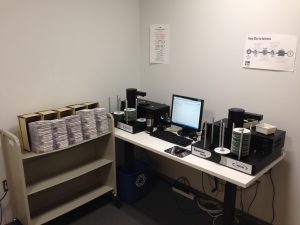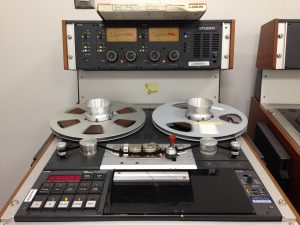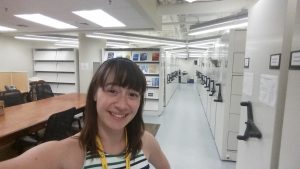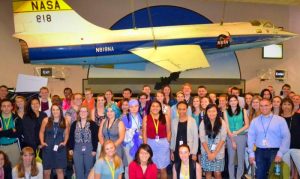The fall of my sophomore year of college, I reached out to a local social-service agency and asked for an internship. I was 100% convinced that I would enter the non-profit world after graduation, and (like most undergrads) I wanted to boost my resume with experience in the field. Much to my disappointment, the agency had already filled their positions. Two days later, I received a phone call from the agency. They were curious- would I be interested in interning with a partner organization instead? The organization turned out to be a small community library. I took a leap of faith and accepted the role. The experience completely altered my career path for the better. It’s the main reason why I’m getting my Master’s in Library & Information Science today.
Needless to say, I’m a big fan of internships. When I applied to Syracuse for grad school, I was glad to see that all library students are required to complete a 150-hour long internship during their time in the program.
Since I started in August, I’ve had the opportunity to talk to fellow MSLIS students and alums about their internship opportunities at the iSchool. I’ve been incredibly impressed by the creative and wide-ranging projects they’ve completed so far. Over the next few months, I’ll be profiling their experiences and professional growth in a series of blogposts.
This week, I’m focusing on two students whose internships fall within the focus area of technical services. Technical Service Librarians are in charge of many behind-the-scenes duties in libraries and museums. They serve as the backbone of an organization, providing necessary services such as cataloguing, preservation, digitization, and the organization of information.
Bryan and Kristin’s internship experiences are awesome examples of ways librarians have indispensable roles in the preservation of national history and scientific research.
Bryan Schuff
Intern for NPR’s Research, Archives, & Data Strategy Team, Summer 2016
MSLIS Candidate 2017

Bryan’s “blue wall headshot” that has become a tradition for all NPR interns.
What did a typical day look as part of the RAD team at NPR?
I’d fill a cup of coffee at the in-house Sound Bites Café, then prep the CD rip-stations (the “robots”) or the Studer tape machines in one of the labs and start digitizing a batch of discs or reels. Each day before noon, the RAD (Research, Archives and Data Strategy) department met for a standing Scrum meeting to briefly update coworkers about what everyone was working on. Sometimes there were intern brown-bag sessions to meet for lunch and learn from NPR personalities (like Caitlin Dickerson, Guy Raz, Ari Shapiro, and Neda Ulaby). In the afternoon, I could run more batches of tapes or CDs, or that’s when more meetings would take place like project sprint reviews and intern sessions, or there might be a Tiny Desk Concert (I saw Blue Man Group, The Jayhawks, and the Secret Sisters)!
I have to be honest with you. I’m not very familiar with the digitization process. Can you map it out for me?
When you digitize in analog formats, such as a tape or record, you have to play it back on the original equipment or a newer version of the equipment and record it in a digital format. It’s a re-recording process. At NPR, I did get to do the hands-on work of digitizing audio tapes. I had never done that before. I had learned about it in theory, in classes like IST 624, but had never done it personally.

One of NPR’s rip station labs with both “robots” at work reformatting CDs to digital files.
What audio tapes were you digitizing?
Some of the earliest ones. NPR started in 1971. The project was focusing on digitizing the earliest tapes. Those are the ones most at risk. I was digitizing mostly All Things Considered and Morning Edition and various other tapes, like recordings of Senate and House committee meetings and recordings of Nixon’s Watergate hearings.
The bulk of NPR’s archives are held at the University of Maryland. We took a couple of field trips up there- first just to visit and get an idea of how many tapes they had and then the next time, we boxed up tapes for a courier to deliver to us at NPR to digitize.

One of the Studer reel-to-reel tape machines playing back an hour of All Things Considered from February 13, 1983.
What was your favorite part of your internship?
My favorite part of the internship was feeling like a full-fledged team member because NPR truly values their interns. I relished the hands-on experience of working with reel-to-reel audiotape, which I had only previously studied in theory, and hearing some stories unfold in real-time once again, such as the Apollo 15 moon landing. Much of it was problem-free, but troubleshooting digital interstitial errors and poorly-wound tape was a valuable experience.
How did this internship influence your current professional goals?
The internship validated my goals and confirmed that I want to keep working toward a career as an audio archivist. I got to work with some of the most knowledgeable people and the best gear under ideal conditions with institutional support: it was a dream come true!
What advice would you give to current library students?
Go for your dream internship and be yourself! I went for it at NPR and I wasn’t sure it could actually happen, but it did, so you just never really know unless you try. Summer can be a busy and competitive time, so if you don’t get your first choice during the summer and you can devote a fall or spring semester to an internship, you might get a better chance then.
[cta_widget block=”cta-lis-a”]
Kristin McAvoy
Intern for the Smithsonian Institution’s Fish & Herpetology Library, Summer 2016
MLIS Candidate 2017

Kristin in the Fish and Herpetology Library at the Smithsonian.
What is the Fish and Herpetology Library? Did it contain artifacts as well as books?
It’s fish and lizards. It’s a book and research collection. Nothing too weird, nothing freaky.
What was your role there? What did a typical day look like?
I had flexible hours, so I would typically get to the Smithsonian around 9 or 9:30. I would first talk to my supervisor, Polly. She was head of multiple libraries: fish and herpetology, birds, and mammals. I would give her an update on where I was and then she would tell me what she wanted me to work on. Typically, it was the same thing every day: to go down and keep trucking.
Then I would go down to the basement of the opposite wing of the Natural History Museum. There was a tiny room that was the office of the library. There, I would meet the researcher who was donating his collection of books to the Smithsonian. I would cross-reference his books with the Smithsonian catalog, with Worldcat, and with the faculty catalog, which shows some things that the public can’t see. Then, I sorted the books into three categories that were marked by three different colored slips of paper. Bright green was books that the Smithsonian didn’t have and were willing to take. Pale green represented books that we might already have a copy of but possibly wanted to keep, especially if it was a newer edition. Bright pink was books that we already had copies of and didn’t want. The researcher would have to take them back.
What was his research in?
He was researching lizards and geckos, mainly in South America.
Were you the one making the call to get rid of books?
Yeah, I was. It was pretty cut and dry. If it wasn’t there, they would take it. That was part of the understanding with the researcher before I got there. Polly would come down and double check everything. I would show her the ones of different qualities.
What was something unexpected about your internship?
I was surprised by how much I got to be involved in the Smithsonian beyond my actual work. I was expecting to be down in the office 30 hours a week and that’s it. There was a lot more- ‘let us explain this,’ ‘come to this meeting and learn this.’ One of the biggest perks was that they expected me to go to staff meetings. It was all mandatory- I got to hear a lot about collection management, budgeting, donations- especially donations. The Smithsonian gets A LOT of donations.
The Smithsonian also takes care of their interns very well. Every week, they would have a tour or a lecture in another Smithsonian Museum for free. They counted it as a part of my internship hours as a learning experience. During a free Planetarium show at the Air and Space Museum, they also showed us- how does this planetarium show run? How does the mechanics behind it work? It was amazing. We also got to go to the Postal Museum and do a scavenger hunt.

Kristin and her fellow Smithsonian interns on a tour of the Air and Space Museum.
How did the internship influence your current professional goals?
It clarified a few things for me. There were definitely aspects of it that I realized I didn’t want to do. It was tedious at times, but it reinforced how much I love working in a Museum setting. It showed me the direction of where I want to go.
What advice would to you give to future students or current students looking for an internship?
Go for it! It was the Smithsonian. I wasn’t expecting to get it. Even though it was open for SU students, there were also thousands of people applying to these internships every year. But I had to try. And I did. My second piece of advice is to make sure that your internship is something you are truly interested in. By the end, I was getting a little antsy with the repetitiveness of my job. It was super informative and educational, but maybe I could have found an internship in preservation or archives instead.
